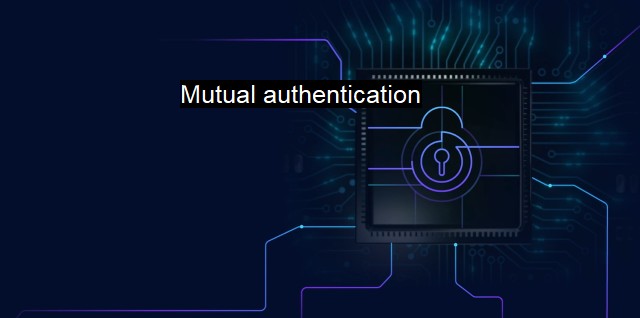What is Mutual authentication?
Importance of Mutual Authentication in Cybersecurity and Antivirus: Verifying Identities to Protect Sensitive Data
Mutual authentication, a fundamental concept refers to a security process whereby both entities involved in a communication process validate each other before proceeding to share any crucial information. Commonly coined as a two-way authentication, mutual authentication is designed to safeguard the sanctity, confidentiality, and integrity of the digital interactions against possible hacking attempts, impersonations, malevolent attacks, and data breaches.On typical grounds, during a communication process, it's usually the server that authenticates the client. with mutual authentication, this approach gets refined and reassures the security necessity by requiring both the client and the server to prove each other’s identity. The underlying mechanism of executing this connection is a two-way street proces, during which the client first verifies the server's digital certificate and upon affirmation, the server asks for validation of the client's credentials.
Mutual authentication, therefore, actively aids in countering prevalent security issues such as man-in-the-middle attacks, where a hacker can impersonate legitimate servers or clients to intercept, monitor, and manipulate the communication by gaining unlawful access. It essentially checks the authenticity of each party involved in the digital exchange, thereby replenishing the much-needed trust.
Considering the vast world of cybersecurity and network environments, mutual authentication is usually utilized in advanced security protocols – like Transport Layer Security (TLS) and Secure Shell (SSH). Such protocols use cryptographic techniques that encapsulate the security essence of mutual authentication for the encryption keys’ exchange during a connection setup. Authenticating the involved parties first helps to mitigate the potential risks of data leakage during this key exchange process.
The fundamental principle of mutual authentication cements the fact that an established secure connection should not be conveniently assumed due to its primary connection to the server. Instead, an elaborate security examination on the client-side must be executed before the server allows any further exchanges—an essential precaution to skew off potential attackers looking to exploit weak points in that primary trust.
One common form of mutual authentication is evident in wireless networks. Typically, these networks remain largely vulnerable due to their architecture and hence are easy to exploit. Mutual authentication, thus, acts as a needed layer of fortification. in the IEEE 802.1X, which is an IEEE Standard for Port-based Network Access Control, mutual authentication procedures provide sufficient mechanisms to counter potential unauthorized access and spoofing attempts.
Antivirus software, on the other hand, also make use of mutual authentication during dynamic action execution, scanning operations, and in updating the virus signature database. In general, we can think of Mutual Authentication as a double-check procedure ensuring a safe link for disrupting any discrepancy, thereby avoiding falsifications and securing communications against external parties, with a better sensitivity towards alterations.
Mutual authentication acts as a guard-wall for cybersecurity in the increasingly perilous landscape of modern digital communications. Its effectiveness helps systems build a trusted peer-to-peer network where accountability and integrity remain tested and verified through a mechanism of reciprocity. Employing mutual authentication controls is thus critical in fortifying systems and marking higher degrees of safety, creating an almost impenetrable defense for businesses and users against pervasive cybersecurity threats. Investing in systems, services, and protocols that adhere to mutual authentication methods is one step towards accomplishing the ultimate goal of achieving secured digital ecosystems to thrive in the digital era seamlessly.

Mutual authentication FAQs
What is mutual authentication in cybersecurity?
Mutual authentication in cybersecurity refers to the process where both servers and clients verify each other's identities before initiating a connection. It ensures that both parties are who they claim to be and mitigates risks of cyberattacks.Why is mutual authentication important in antivirus software?
Mutual authentication is important in antivirus software because it ensures that the software is communicating with a legitimate server or client. It helps prevent viruses or other malicious code from infiltrating the system by verifying the authenticity of the software itself.What are the benefits of using mutual authentication in cybersecurity?
Using mutual authentication in cybersecurity provides several benefits such as enhanced security, protection against man-in-the-middle attacks, and reduced risk of unauthorized access. It also helps companies maintain compliance with industry regulations and ensures secure communication between servers and clients.How does mutual authentication differ from one-way authentication?
Mutual authentication differs from one-way authentication in that it requires both the server and client to authenticate each other's identity before establishing a connection. One-way authentication, on the other hand, only requires one party, either the server or the client, to authenticate its identity.| | A | | | B | | | C | | | D | | | E | | | F | | | G | | | H | | | I | | | J | | | K | | | L | | | M | |
| | N | | | O | | | P | | | Q | | | R | | | S | | | T | | | U | | | V | | | W | | | X | | | Y | | | Z | |
| | 1 | | | 2 | | | 3 | | | 4 | | | 7 | | | 8 | | |||||||